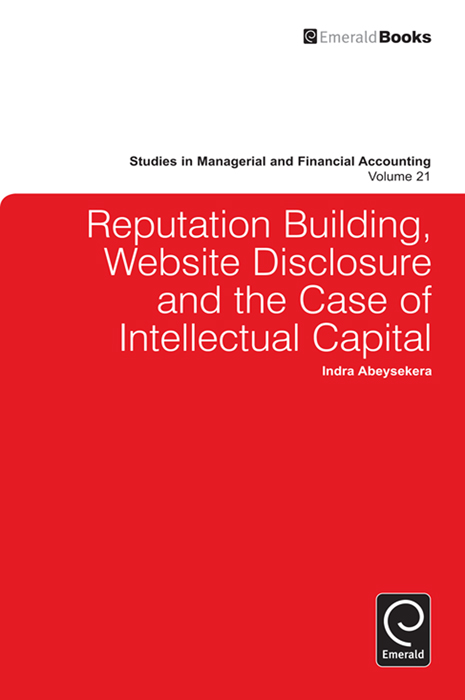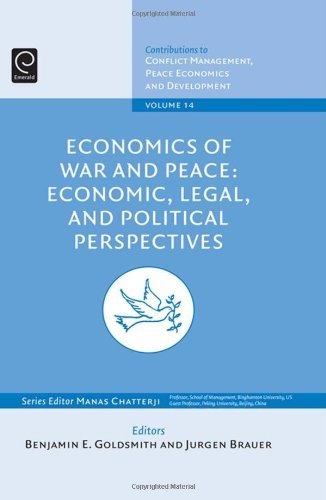Emerald Group Publishing Limited (Books and Journals)
48 results for Emerald Group Publishing Limited (Books and Journals)
-
 Reputation Building, Website Disclosure and the Case of Intellectual Capital (vol. 21)
by:
Emerald Group Publishing Limited, 2010
Reputation Building, Website Disclosure and the Case of Intellectual Capital (vol. 21)
by:
Emerald Group Publishing Limited, 2010
-
 Economics of War and Peace: Economic, Legal, and Political Perspectives
by:
Emerald Group Publishing Limited, 2010
Economics of War and Peace: Economic, Legal, and Political Perspectives
by:
Emerald Group Publishing Limited, 2010
- References
-
Chapter 3 Theoretical framework
This chapter describes signalling theory, which is used to interpret the findings. Section 3.2 outlines the implications of signalling theory as a way of correcting market failure through voluntary disclosure. Section 3.3 discusses theoretical constructs, outlining independent variables, interaction of independent variables and mediating variables. Section 3.4 outlines the empirical model used...
- Subject Index
-
Chapter 8 Findings and interpretation – Interviews
This chapter outlines the findings from the interviews conducted with company directors, chief executive officers or senior executives that meet the third objective of this study. Section 8.2 outlines the aims of intellectual capital disclosure of the fastest growing firms on company-sponsored websites. Section 8.3 explains the reasons behind selection of disclosure types on website disclosure –...
- Dedication
-
Chapter 6 Findings and interpretation – Content analysis
This chapter outlines findings for the first objective of the study from the model in order to determine the effectiveness of disclosure as predictors of revenue growth reputation. Section 6.2 outlines the results analysed by frequency count and sentence count. Section 6.3 outlines the results of categories of intellectual capital, namely internal, external and human capital and provides a...
- Studies in Managerial and Financial Accounting
-
Appendices
The following is an introductory profile of the fastest growing firms over the three-year period of the study listed by corporate reputation ranking order. The business activities in which the firms are engaged are outlined to provide background information for the reader.
- Studies in Managerial and Financial Accounting
-
Chapter 9 Conclusions
This chapter provides a brief overview of the contents of this report and evaluates its contribution to the literature. Section 9.2 briefly summarises the motivation behind the study and the scope of the research. Section 9.3 briefly summarises the data, methodology and results. Section 9.4 outlines policy recommendations. Section 9.5 describes the limitations of this study. The last section...
- Copyright page
- List of Figures
- List of Tables
-
Chapter 5 Sample characteristics
This chapter describes some of the characteristics of the firms analysed in this study. Section 5.2 outlines the size of firms, measured by annual revenue and employee numbers. It then discusses the implications for reporting entity status, preparing general-purpose financial reports and annual reports. Section 5.3 outlines the intellectual capital disclosure signals – narrative, visual and...
- List of Charts
- List of Appendix Sections
-
Chapter 2 Literature review
This chapter provides a review of the literature relating to intellectual capital and firm performance in the context of corporate reputation. Section 2.2 outlines the definitions of intellectual capital and how they differ from the definitions offered for intangibles by accounting regulators. Section 2.3 reviews the categorisation of intellectual capital and looks at two major models of...
-
Chapter 7 Findings and interpretation – Survey questionnaire
This chapter outlines findings from the questionnaire survey that meets the second objective of this study. Section 7.2 outlines a comparison between intellectual capital value drivers perceived by directors as important for the revenue growth aspect of revenue growth reputation and intellectual capital value drivers disclosed on company-sponsored websites. Section 7.3 outlines linear regression...
-
Executive Summary
This study gave rise to four policy recommendations. First, firms are encouraged to use both narrative and visual forms of disclosure to complement one another in disclosing intellectual capital resource items on websites. Secondly, it is important to conduct an awareness program about intellectual capital disclosure on websites so that small firms become aware of the positive impact such...
-
Chapter 4 Research methods
This chapter describes the research methods used in this study. Section 4.2 introduces the content analysis of company-sponsored websites. Section 4.3 outlines the intellectual capital disclosure signals – narrative, visual and numerical – and their measurement. Section 4.4 introduces the recording of quantified intellectual capital disclosure signals within the coding framework. Section 4.5...
-
Chapter 1 Introduction and overview
This chapter introduces intellectual capital and intellectual capital disclosure and provides an overview of the subsequent chapters of the study. Section 1.2 outlines the relevance of intellectual capital in the present context. Section 1.3 explains the motivation for undertaking a study investigating revenue growth reputation and intellectual capital. Section 1.4 explains the aims and...
- Acknowledgements
-
Chapter 11 Regional integration and militarised interstate disputes: An empirical analysis
Purpose – This chapter aims to position regional integration in the Kantian peace tripod and to test whether regional economic integration has a significant effect in reducing militarised interstate disputes.Methodology – It uses logistic regression on cross-sectional–time-series data and a generalised estimating equation.Findings – The analysis shows that regional integration had a significant...
-
Chapter 4 Arms export controls and the proliferation of military technology
Purpose – To examine the implications of arms export controls on the international spread of weapons production and innovation.Methodology/approach – The chapter analyses predicted responses to arms export controls, drawing on existing literature. It considers incentives to potential buyer countries to develop their own substitutes and a case study of Australia's response to US denial of access...
-
Foreword
The book includes a set of chapters primarily to investigate the link between economics and conflicts. Although the subject matter has been presented in some other volumes in this series, this book spans a wider area covering cross fertilisation of disciplines and the role of law and institutions. The cross-disciplinary approach is necessary because some pure economists are presenting their...
-
About the authors
Aditya Agrawal is a scholarship graduate from Bond University (2006, first class honors in Management Science) and the 2007–2008 summer scholar at the Strategic and Defence Studies Centre, Australian National University. He commenced work at the University College, Australian Defence Force Academy in June 2008 and is currently reading for his doctorate in military outsourcing. Previously he has...
-
Chapter 2 A method to compute a peace gross world product by country and by economic sector
Purpose – The chapter reports on an attempt to compute the size of gross world product (GWP) under the assumption that all violence ceases.Methodology/approach – Spreadsheet-based simulations, given seed values taken from extensive literature review; this is done, for 2007, in nominal foreign exchange–based US dollars (USD) as well as in purchasing power parity (ppp)–based dollars (international...
-
Chapter 6 Terrorism and violent internal conflict in post-soeharto Indonesia: Beyond the Jihadi prism of analysis
Purpose – Since September 2001, most studies of terrorism have focused on the motives and operations of transnational terrorist groups, especially Islamist jihadi groups. Yet statistics from the past decade indicate that most terrorist attacks occurred within violent internal conflicts. Indonesia is a case in point. Following the fall of the Soeharto regime in 1998, terrorism became a hallmark of
- Author Index
-
Chapter 5 Probing the roles of governance and greed in civil strife in West Africa
Purpose – This chapter aims to explore the causes of civil war in West Africa, including the perspectives of those directly involved, both those involved voluntarily and those involved against their will. To this end, we examine the three contiguous war – afflicted coastal countries of Sierra Leone, Liberia and Ivory Coast and as a counterweight, Ghana which has escaped civil war.Methodology –...
